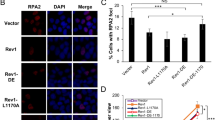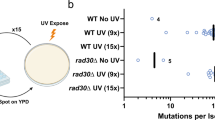Abstract
Human DNA polymerase η (Pol η) modulates susceptibility to skin cancer by promoting DNA synthesis past sunlight-induced cyclobutane pyrimidine dimers that escape nucleotide excision repair (NER)1,2. Here we have determined the efficiency and fidelity of dimer bypass. We show that Pol η copies thymine dimers and the flanking bases with higher processivity than it copies undamaged DNA, and then switches to less processive synthesis. This ability of Pol η to sense the dimer location as synthesis proceeds may facilitate polymerase switching before and after lesion bypass. Pol η bypasses a dimer with low fidelity and with higher error rates at the 3′ thymine than at the 5′ thymine. A similar bias is seen with Sulfolobus solfataricus DNA polymerase 4, which forms a Watson–Crick base pair at the 3′ thymine of a dimer but a Hoogsteen base pair at the 5′ thymine (ref. 3). Ultraviolet-induced mutagenesis is also higher at the 3′ base of dipyrimidine sequences4,5,6. Thus, in normal people and particularly in individuals with NER-defective xeroderma pigmentosum who accumulate dimers, errors made by Pol η during dimer bypass could contribute to mutagenesis and skin cancer.
This is a preview of subscription content, access via your institution
Access options
Subscribe to this journal
Receive 51 print issues and online access
$199.00 per year
only $3.90 per issue
Buy this article
- Purchase on Springer Link
- Instant access to full article PDF
Prices may be subject to local taxes which are calculated during checkout



Similar content being viewed by others
References
Masutani, C. et al. The XPV (xeroderma pigmentosum variant) gene encodes human DNA polymerase η. Nature 399, 700–704 (1999)
Johnson, R. E., Kondratick, C. M., Prakash, S. & Prakash, L. hRAD30 mutations in the variant form of xeroderma pigmentosum. Science 285, 263–265 (1999)
Ling, H., Boudsocq, F., Plosky, B. S., Woodgate, R. & Yang, W. Replication of a cis–syn thymine dimer at atomic resolution. Nature 424, 1083–1087 (2003)
Armstrong, J. D. & Kunz, B. A. Site and strand specificity of UVB mutagenesis in the SUP4-o gene of yeast. Proc. Natl Acad. Sci USA 87, 9005–9009 (1990)
Dumaz, N., Stary, A., Soussi, T., Daya-Grosjean, L. & Sarasin, A. Can we predict solar ultraviolet radiation as the causal event in human tumours by analyzing the mutation spectra of the p53 gene? Mutat. Res. 307, 375–386 (1994)
Hsia, H. C., Lebkowski, J. S., Leong, P.-M., Calos, M. P. & Miller, J. H. Comparison of ultraviolet irradiation-induced mutagenesis of the lacI gene in Escherichia coli and in human 293 cells. J. Mol. Biol. 205, 103–113 (1989)
Kokoska, R. J., McCulloch, S. D. & Kunkel, T. A. The efficiency and specificity of apurinic/apyrimidinic site bypass by human DNA polymerase η and Sulfolobus solfataricus Dpo4. J. Biol. Chem. 278, 50537–50545 (2003)
Masutani, C., Kusumoto, R., Iwai, S. & Hanaoka, F. Mechanisms of accurate translesion synthesis by human DNA polymerase η. EMBO J. 19, 3100–3109 (2000)
Park, H. et al. Crystal structure of a DNA decamer containing a cis–syn thymine dimer. Proc. Natl Acad. Sci USA 99, 15965–15970 (2002)
Washington, M. T., Prakash, L. & Prakash, S. Mechanism of nucleotide incorporation opposite a thymine–thymine dimer by yeast DNA polymerases η. Proc. Natl Acad. Sci. USA 100, 12093–12098 (2003)
Boudsocq, F., Iwai, S., Hanaoka, F. & Woodgate, R. Sulfolobus solfataricus P2 DNA polymerase IV (Dpo4): an archaeal DinB-like DNA polymerase with lesion-bypass properties akin to eukaryotic pol η. Nucleic Acids Res. 29, 4607–4616 (2001)
Shcherbakova, P. V., Bebenek, K. & Kunkel, T. A. Functions of eukaryotic DNA polymerases. Sci. Aging Knowledge Environ. [online], 26 February 2003 〈sageke.sciencemag.org/cgi/content/full/sageke;2003/8/ref3〉
Trincao, J. et al. Structure of the catalytic core of S. cerevisiae DNA polymerase η: implications for translesion DNA synthesis. Mol. Cell 8, 417–426 (2001)
Ling, H., Boudsocq, F., Woodgate, R. & Yang, W. Crystal structure of a Y-family DNA polymerase in action: a mechanism for error-prone and lesion-bypass replication. Cell 107, 91–102 (2001)
Johnson, R. E., Washington, M. T., Prakash, S. & Prakash, L. Fidelity of human DNA polymerase η. J. Biol. Chem. 275, 7447–7450 (2000)
Friedberg, E. C., Walker, G. C. & Siede, W. DNA Repair and Mutagenesis 544–555 (ASM, Washington DC, 1995)
Matsuda, T., Bebenek, K., Masutani, C., Hanaoka, F. & Kunkel, T. A. Low fidelity DNA synthesis by human DNA polymerase-η. Nature 404, 1011–1013 (2000)
Matsuda, T. et al. Error rate and specificity of human and murine DNA polymerase η. J. Mol. Biol. 312, 335–346 (2001)
Prakash, S. & Prakash, L. Translesion DNA synthesis in eukaryotes: a one- or two-polymerase affair. Genes Dev. 16, 1872–1883 (2002)
Bresson, A. & Fuchs, R. P. Lesion bypass in yeast cells: Pol η participates in a multi-DNA polymerase process. EMBO J. 21, 3881–3887 (2002)
Marini, F., Kim, N., Schuffert, A. & Wood, R. D. POLN, a nuclear PolA family DNA polymerase homologous to the DNA cross-link sensitivity protein Mus308. J. Biol. Chem. 278, 32014–32019 (2003)
O'Day, C. L., Burgers, P. M. J. & Taylor, J. PCNA-induced DNA synthesis past cis–syn and trans–syn-I thymine dimers by calf thymus DNA polymerase δ in vitro. Nucleic Acids Res. 20, 5403–5406 (1992)
Tissier, A. et al. Misinsertion and bypass of thymine–thymine dimers by human DNA polymerase ι. EMBO J. 19, 5259–5266 (2000)
Nelson, J. R., Lawrence, C. W. & Hinkle, D. C. Thymine–thymine dimer bypass by yeast DNA polymerase ζ. Science 272, 1646–1649 (1996)
Zhang, Y. et al. Lesion bypass activities of human DNA polymerase µ. J. Biol. Chem. 277, 44582–44587 (2002)
Ohashi, E. et al. Error-prone bypass of certain DNA lesions by the human DNA polymerase κ. Genes Dev. 14, 1589–1594 (2000)
Zhang, H. & Siede, W. UV-induced T → C transition at a TT photoproduct site is dependent on Saccharomyces cerevisiae polymerase η in vivo. Nucleic Acids Res. 30, 1262–1267 (2002)
Murata, T., Iwai, S. & Ohtsuka, E. Synthesis and characterization of a substrate for T4 endonuclease V containing a phosphorodithioate linkage at the thymine dimer site. Nucleic Acids Res. 18, 7279–7286 (1990)
Acknowledgements
We thank Y. Pavlov and K. Bebenek for discussions and comments on the manuscript.
Author information
Authors and Affiliations
Corresponding author
Ethics declarations
Competing interests
The authors declare that they have no competing financial interests.
Supplementary information
Supplementary Table
Data for fidelity analysis. (PDF 45 kb)
Rights and permissions
About this article
Cite this article
McCulloch, S., Kokoska, R., Masutani, C. et al. Preferential cis–syn thymine dimer bypass by DNA polymerase η occurs with biased fidelity. Nature 428, 97–100 (2004). https://doi.org/10.1038/nature02352
Received:
Accepted:
Issue Date:
DOI: https://doi.org/10.1038/nature02352
This article is cited by
-
The HLTF–PARP1 interaction in the progression and stability of damaged replication forks caused by methyl methanesulfonate
Oncogenesis (2020)
-
Translesion synthesis DNA polymerase η exhibits a specific RNA extension activity and a transcription-associated function
Scientific Reports (2017)
-
Molecular architecture of the Ub-PCNA/Pol η complex bound to DNA
Scientific Reports (2015)
-
A nucleotide binding rectification Brownian ratchet model for translocation of Y-family DNA polymerases
Theoretical Biology and Medical Modelling (2011)
-
PIDD orchestrates translesion DNA synthesis in response to UV irradiation
Cell Death & Differentiation (2011)
Comments
By submitting a comment you agree to abide by our Terms and Community Guidelines. If you find something abusive or that does not comply with our terms or guidelines please flag it as inappropriate.



